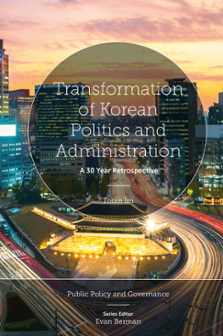
Index
Transformation of Korean Politics and Administration: A 30 Year Retrospective
ISBN: 978-1-80382-116-0, eISBN: 978-1-80382-115-3
ISSN: 2053-7697
Publication date: 9 May 2022
Citation
Im, T. (2022), "Index", Transformation of Korean Politics and Administration: A 30 Year Retrospective (Public Policy and Governance, Vol. 35), Emerald Publishing Limited, Leeds, pp. 215-222. https://doi.org/10.1108/S2053-769720220000035042
Publisher
:Emerald Publishing Limited
Copyright © 2022 Emerald Publishing Limited
INDEX
Note: Page numbers followed by “n” indicate notes.
- Prelims
- Chapter 1: Introduction: A Constantly Growing Economy
- Part I: Changes in the Administrative Environment
- Chapter 2: Changes in Demographic Structure
- Chapter 3: The Wave of Informatization
- Chapter 4: Changes in the Occupational World
- Part II: Changes in the Political-Administrative System
- Chapter 5: Democratization of the Electoral System
- Chapter 6: The President and Internal Administration
- Chapter 7: Administrative Reform
- Chapter 8: Changes in Capacity Management Methods
- Chapter 9: Change of Power in the Legislature
- Chapter 10: Changes in the Judiciary
- Chapter 11: Local Government and Decentralization
- Part III: The Next 30 Years
- Chapter 12: Pessimistic Scenario
- Chapter 13: Optimistic Scenario: Middle-Power Nation
- Chapter 14: Prerequisites for the Optimistic Scenario: Trust in Government
- Appendix: Major Events by Regime
- References
- Index